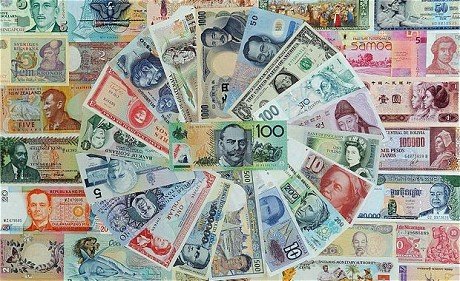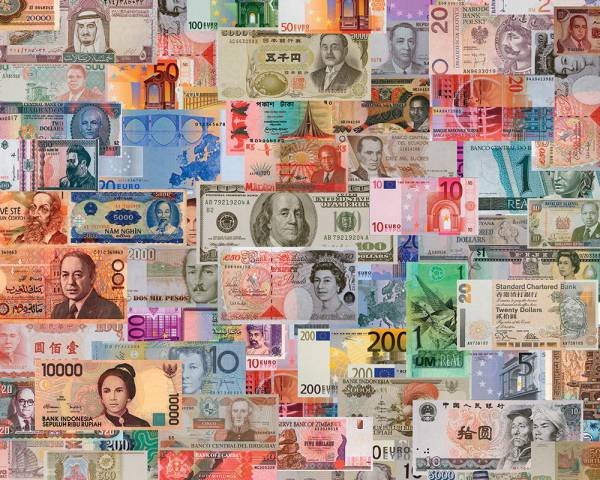
When we go to any store or establishment to make our daily purchase we give in return some papers that contain a number engraved on it, which symbolizes the value they have to make exchanges.
But what exactly does it make us trust in the figure that appears printed on any bill money? If you realize, the only difference that exists between a bill and another of another denomination, in fact, its color and the figure that appears printed, but it is the same paper and, nevertheless, the value between one and another paper is very different.

So what determines the actual value physically? Well, going back to metals every metal (diamond, gold, silver, copper, steel, aluminum, etc.) if it has its representative value both for exchange and its use value since these metals could melt and create precious jewels.
There are countries in which to carry a fortune in your pocket you just have to carry a bill. And there are others in which you can carry a backpack full of high denomination paper money with little value.
With this I have other questions that I would like you to answer:
Can the Government use to print any value to their currencies? Could governments print so many bills to face their debts? What is the negative effect on a nation?
I will reward your answers using the rewards system @steem-bounty.


@jmhb85 has set 0.500 STEEM bounty on this post!
Bounties are a new way you can earn rewards irrespective of you Steem Power. Go here to learn how bounties work.
Earn the bounty by commenting what you think the bounty creator wants to know from you.
Find more bounties here and become a bounty hunter.
Happy Rewards Hunting!
Congratulations to the following winner(s) of the bounty!
Find more bounties here and become a bounty hunter.@oclinton has earned 0.192 STEEM. 0.192 STEEM from the creator of the bounty!
Find more bounties here and become a bounty hunter.@frdem3dot0 has earned 0.136 STEEM. 0.134 STEEM from the creator of the bounty and 0.002 STEEM from the community!
Find more bounties here and become a bounty hunter.@intellihandling has earned 0.122 STEEM. 0.115 STEEM from the creator of the bounty and 0.007 STEEM from the community!
There are typical example of what means for a country economy to print too much money like Venezuela and Zimbabwe where inflaction is so big that their money value is almost like the cost of print and paper...
The Venezuelan economy is very sad.
The value of fiat money is a shared illusion. It is a story, but by believing that story, it becomes real (at least partially).
The government can try to print more and more money, but that does never work in the long run. The reason is twofold. First when people start to doubt that story, the entire currency starts to crumble. The government has to keep the trust in the currency high and printing huge amounts destroys that trusts. They have to invent stories, such as printing money to keep up with the economic growth, or fighting deflation..... just so the people keep their full faith.
The second problem is that the markets are actually smarter than the politicians. The markets simply readjust all the prices. The government printing money does not create wealth, it is just stealing wealth from the savers.
Well said, it's a shared illusion
There is no value to billed money its just an arbitrary calculation that we've all simply accepted as percieved value and buying power
In addition to the second question
If governments print money to pay off the national debt, inflation would rise. This increase in inflation would reduce the value of government bonds.
If inflation increases, people will not want to hold bonds because their value is falling. Therefore, the government will find it difficult to sell bonds to finance the national debt. They will have to pay higher interest rates to attract investors.
If the government print too much money and inflation get out of hand, investors will not trust the government and it will be hard for the government to borrow anything at all.
Therefore, printing money could create more problems than it solves
I think it would solve the day to day, but it would really end the economy of a country without quick recovery. Thanks for your extensive explanation.
Thank also for the nice economic question
Short and simple said the "value" of a bill just exists because of peoples trust in this value.
To be honest I do not really understand what you mean with your first question: "Can the Government use to print any value to their currencies?"
To the printing many bills to face debts question: that is exactly what is happening in Venezuela at the moment. Their economy crashes and many people are so poor they can't even buy themselves food. Usually it is or at least should not be possible for the government to print money as they wish. Theoretically (!!!) the government has no power concerning how much money is printed but yeah if the just do it as it has happened in Venezuela the HUGE negative effect of it is hyperinflation (the fact that Venezuelas leadership didn't thought about that or if they thought about it but still went on is just so bizarre).
The first question
Money is a both a good and a method of exchange. As a good, it has a limited supply, and therefore there is a demand for it. There is a demand because people can use the money to purchase the goods and services they need and want.
Therefore money is treated like like any other goods whose value is determined by the forces of demand and supply.
To the second question;
why government’s don’t print more money to deal with the problem of national debt:
The reason is that printing more money doesn’t increase economic output in any way – it merely causes inflation.
Yes, every country can print as much money as they want. However, printing too much money creates inflation, making savings in that currency lose value and buying another currency more expensive.
I think the currency more protected against that effect is the euro, because many countries must agree to print more money so it is less likely that euro will lose value.
Posted using Partiko Android
Short term, yes. Long term, no
Why? Because too much money/demoninations in circulation actually weaken the existing money.